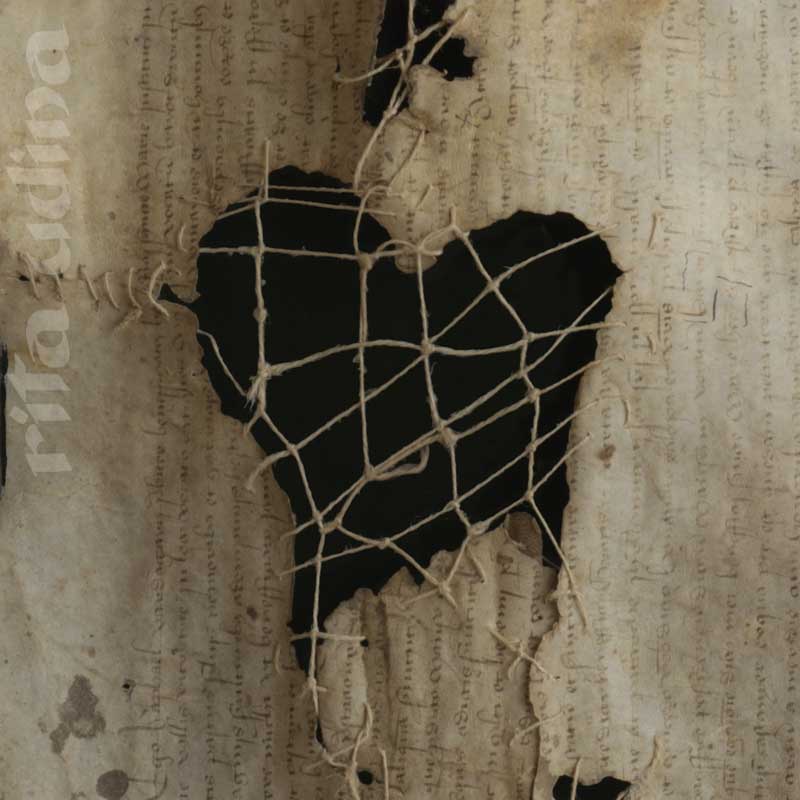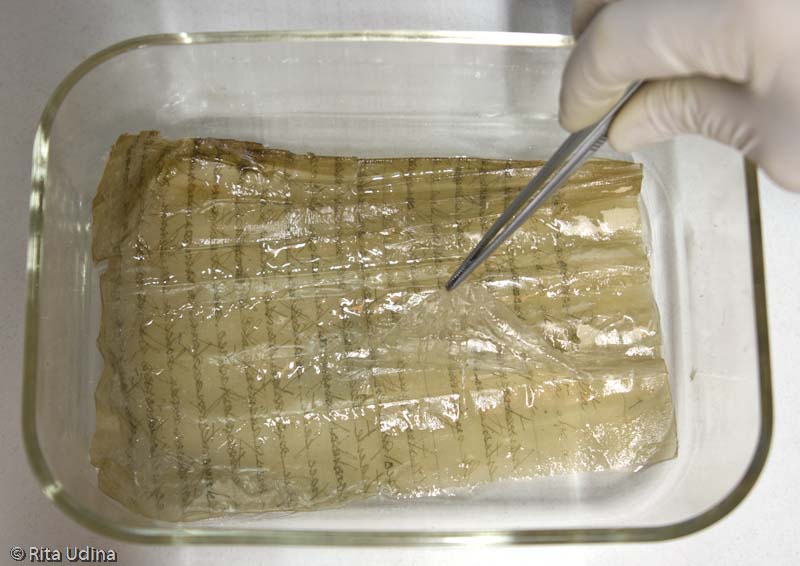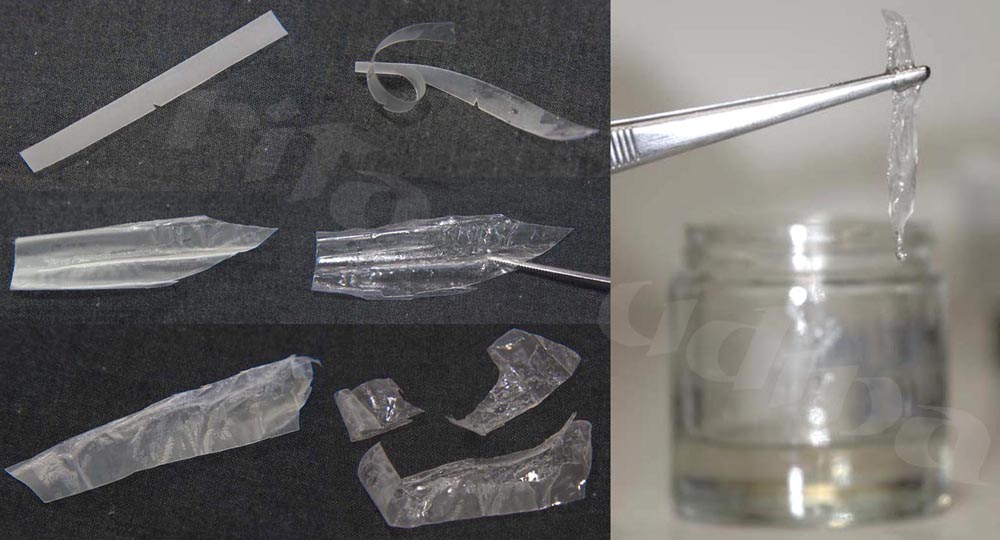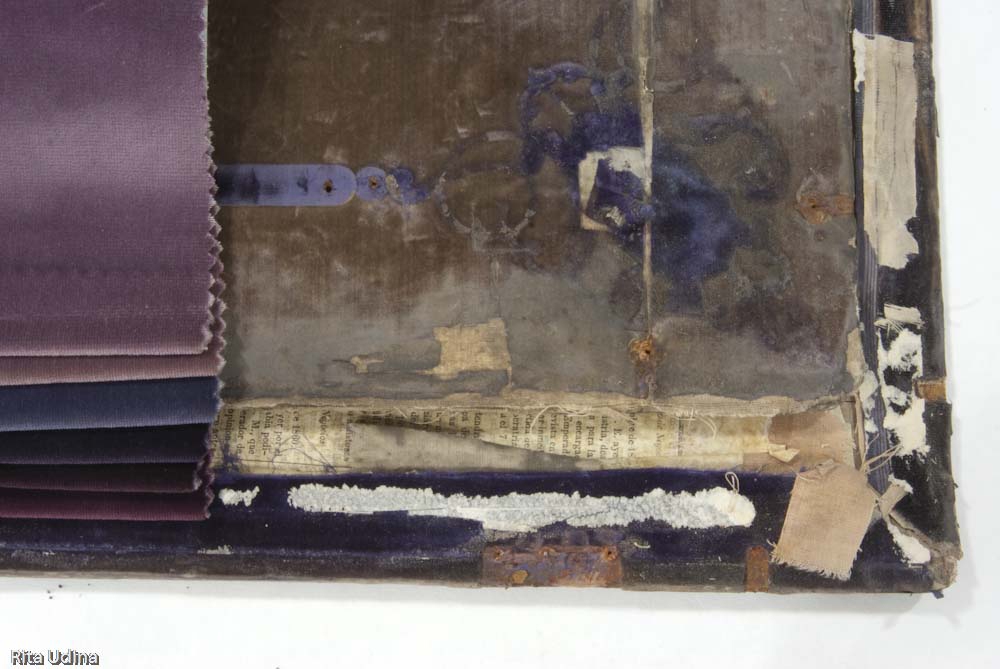old treatments
Find below the blog posts related to old treatments:
Premiere of the video of the conservation treatment of a map
Premiere of the video showing the full conservation treatment of an oversized hand-coloured map, varnished and lined on a canvas. Do not miss it! Next Thursday 27 at 4pm CEST (UTC+2).
Retouching, a taboo in paper conservation?
Retouching is among the most sensitive within ethics in conservation since it means to establish the aspect a restored object is expected to have. My opinion is that the looks of an historical object is often as important as its physical-chemical condition, and not intervening provides poor results that might mislead its readability more than a proper intervention. The more we intend to make it as neutral as possible, the least arbitrary, we need to admit that retocuhing requires good taste.
Silver Mirroring Removal in Photographs (Video)
At last a deffinitive method, safe and efficient for silver mirroring removal in historical photographs. This new treatment will change the way the issue of silver mirroring removal has been addressed in photographic collections. See it in this video and value the results.
Untangling tensions, for an improved 2019
We wish you merry Chrsitmas and a better (and restored) 2019, untangling knots and tensions, at least those from parchment manuscripts.
Hold on and suck in, Miss Scarlett! Removing a plastic corset from a manuscript
A personal story, a historic manuscript, a crazy laminating machine and a final outcome. All these ingredients are seasoned with PFTE, TFA, HFIP, PE, DMSO, PET... cling, dong and BOOM!... An explosive -but most irresistible- cocktail. We'll discuss about synthetic polymers, sorts of laminations and encapsulation.
“Smart books” and bibliographic terrorism
Terrorists do not always carry explosives or mallets, nor they come from overseas, it may even be people in charge of collections. We ought to deal with them to safeguard "smart books": books intelligently made, such that no material interfere with each other, on the contrary, they create formidable synergies. Each one has its peculiarities, its beauty and its function. They represent a compendium of technology, art, society and culture at the time and place in which they were created.
Bibliopaths: The case of the lacquer binding
Are we supposed to fear bibliopaths? Or maybe we should give them an award? Who are they? Atention! Because they can be among us, or we might even be one of them?! I invite you to read the Case of the Lacquer Binding to know more about them
Choirbooks, and much more, at the Spanish National Library
Led by Luis Crespo and Arsenio Sanchez, restorerss in the National Library, we visit the fascinating world of book illuminated miniatures, choir books, manuscripts ... Latest technological resources, ancient tradition, and above all their experience and knowledge, allow the recovery of these bibliographic jewels exhibited now at the National Library of Spain.
Who says BluTack® is ideal for papers?
BluTack in papers? Never! Restoration of a document from industrial heritage with a stain from this adhesive, property of the Municipal Archive (Barcelona)
Gone with the wind
I don’t like much having war books, but I must admit that this one is particularly beautiful. The velvet binding seemed to me a challenging issue on the restoration, which did not have major complications besides this. I show the restoration of this book because of the headaches it has given me when solving the lost areas, the wooden work. The considerable losses on a laborious woodcarving work, and the lack of originals of many of the missing pieces fairly complicated the subject (the shields on the corners were different).
Categories
ARTEFACT
archive or library
book
book structures
bundle
headband
hollow back
limp-vellum binding
locks
sewing
tight back
document
seal
lacquered seal
printed stamp (see TECHNIQUE)
drawing
manuscript
photograph
albumen
daguerreotype
glass plate
silver gelatine
plans, maps, architectural or technical drawings
maps
plans
poster
DAMAGES
acidity / oxidation
bibliopath - graphopath
Bookbugs (pests & paper eaters)
insects
silverfish
woodworm
microorganisms
mold
disaster
flood
foxing
losses, gaps
pressure sensitive tapes
silver mirroring
structural
wrinkles
MATERIAL
fabric
cotton
silk
velvet
glass
leather
parchment
metal
paper
coated paper (art paper)
Kraft paper
laid paper
rag paper
tracing paper
impregnated paper
onion skin paper
Washi
wood pulp paper
plastic
cellulose acetate
polyethylene terephthalate (PET)
Polypropylene (PP)
wood
PRODUCTS
adhesives
natural
shellac
rubber (natural)
starch paste
synthetic adhesives
Filmoplast®
Paraloid B72
rubber (synthetic)
Tylose® (MHC)
gels
agarose
chemical gel
hydro-gels
Klucel®
organo-gels
physical gels
Velvesil Plus
xanthan gel
nanoparticles
solvent
benzyl alcohol
ciclometicone
diethyl carbonate
dimethyl sulfoxide (DMSO)
polyethylene glycol (PEG)
surfactants
TECHNIQUE
ballpoint pen
collage
felt-tip pen
gouache
graphite (pencil)
ink
print
engraving
etching
lithograph
woodcut
printed stamp
reproduction
diazotype
watercolour
THEORY on cons. & rest.
TOOLS, MACHINES
TREATMENTS
bleaching
light bleaching
cleaning
stain removal
surface cleaning
tape removal
varnish removal
wet cleaning
deacidification
digitization
flattening
flattening under tension
housing (storage)
box
folder
four flaps envelopes
inpainting
mimetic in-painting
neutral colour in-paint
mould treatment
preventive conservation
climate (HR, temp.)
re-binding
reinforcement - consolidation
backing with fabric
Infilling
leafcasting
ink fixing
lining
sizing
tear repair
varnishing
















